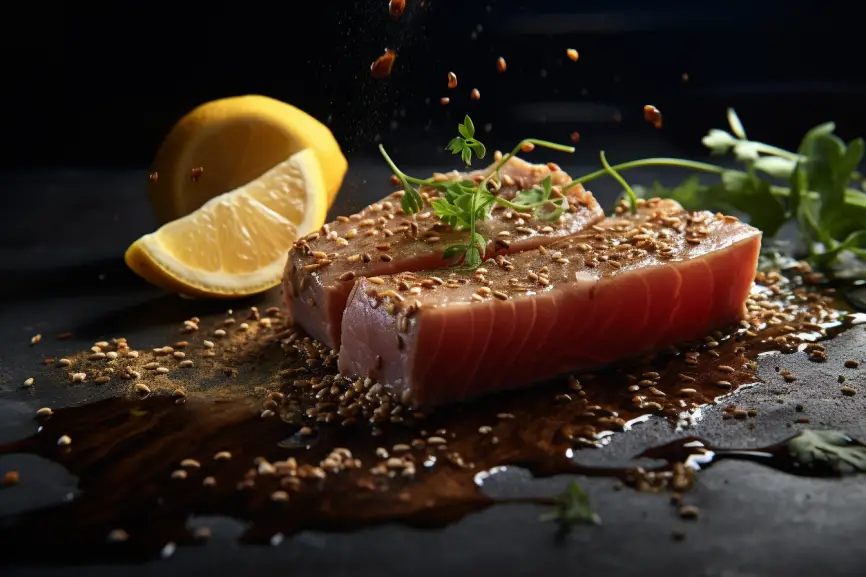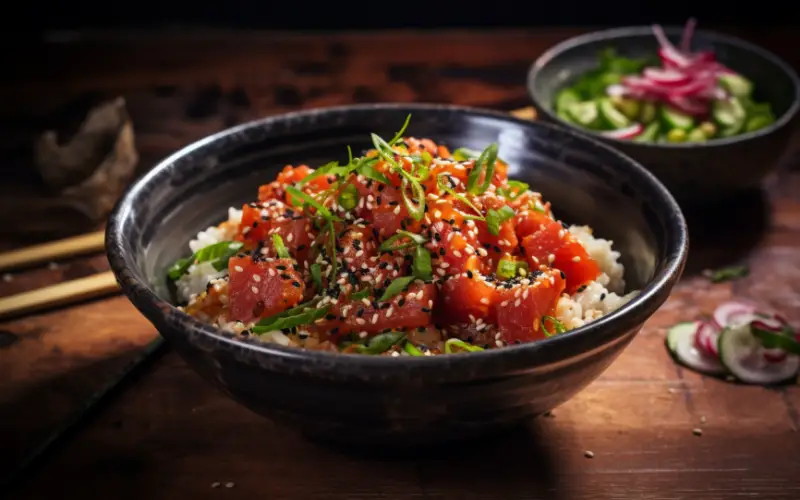Table of Contents Show
Tuna, a prized fish known for its meaty texture and delicate flavor, has become a staple in kitchens worldwide. Whether you enjoy it seared, grilled, or canned, tuna offers incredible versatility and adaptability in a variety of dishes. But have you ever wondered what ingredients go well with tuna to create the ultimate culinary experience?
In this comprehensive guide, we will delve into the art of pairing tuna with a wide array of complementary ingredients. From vibrant vegetables and succulent fruits to hearty grains and legumes, we will explore the countless possibilities that elevate the flavors and textures of tuna-based dishes. Additionally, we will uncover the magic of sauces, condiments, and herbs that can transform a simple tuna recipe into a culinary masterpiece.

Before we embark on this flavorful journey, let’s take a moment to understand the significance of pairing tuna with the right ingredients. While tuna undoubtedly possesses its unique taste, pairing it with complementary flavors and textures can enhance its natural qualities, creating a harmonious marriage of ingredients on your plate. By selecting the right ingredients, you can balance the richness of tuna, add contrasting notes, and elevate the overall taste experience.
The popularity of tuna as a versatile ingredient is not without reason. With its mild yet distinct flavor, tuna lends itself well to a variety of culinary preparations, making it a go-to choice for both professional chefs and home cooks alike. Furthermore, tuna offers numerous health benefits, being an excellent source of lean protein, Omega-3 fatty acids, and essential vitamins and minerals. Incorporating tuna into your diet not only provides a delicious meal but also contributes to a well-rounded and nutritious eating plan.
To fully appreciate the art of pairing tuna, it’s crucial to understand the different types of tuna available in the market. Yellowfin, Albacore, Skipjack, and Bluefin are among the most commonly consumed varieties, each offering its unique taste profile and texture. Additionally, we will explore the various forms of tuna, including fresh, canned, and frozen, understanding how each variation can impact the pairing possibilities.
As we dive deeper into this guide, we will also touch upon the importance of sustainable sourcing and purchasing tips to ensure that your tuna choices align with environmentally friendly practices. Taking steps to support sustainable fishing ensures the long-term viability of tuna populations and protects our oceans for future generations.
So, whether you are a seasoned tuna enthusiast looking to expand your culinary repertoire or a newcomer eager to explore the world of tuna pairings, this guide is designed to equip you with the knowledge and inspiration needed to create unforgettable meals. Join us as we unlock the secrets of what goes well with tuna, and get ready to embark on a flavorful adventure that will tantalize your taste buds and leave you craving more.
Understanding Tuna
Tuna, a popular fish that graces the tables of many seafood lovers, is not only delicious but also offers a wide range of nutritional benefits. Before we dive into the world of tuna pairings, it’s essential to understand the different types of tuna available and the nuances that come with each variety.

- Types of Tuna:
- Yellowfin Tuna: Known for its mild flavor and tender texture, yellowfin tuna is a favorite choice for sushi and sashimi. It boasts a slightly pinkish color and is often enjoyed raw or lightly seared.
- Albacore Tuna: Albacore tuna, also referred to as “white tuna,” has a mild and delicate flavor with a slightly firmer texture. It is commonly used in canned tuna products and is versatile enough to be used in a wide range of recipes.
- Skipjack Tuna: Skipjack tuna is a more affordable option compared to other types. It has a stronger flavor and darker flesh, making it ideal for dishes that require a bolder taste.
- Bluefin Tuna: Known for its rich and buttery flavor, bluefin tuna is highly sought after by seafood connoisseurs. It is often considered a delicacy and is prized for its exquisite taste and melt-in-your-mouth texture.
- Nutritional Benefits of Tuna: Tuna is not only delicious but also packs a nutritional punch. It is an excellent source of lean protein, making it an ideal choice for those looking to incorporate more protein into their diet. Additionally, tuna is rich in Omega-3 fatty acids, which are essential for heart health and brain function. These fatty acids have been linked to numerous health benefits, including reducing inflammation, improving cognitive function, and supporting a healthy cardiovascular system. Tuna is also a good source of vitamins and minerals such as vitamin D, vitamin B12, selenium, and potassium.
- Different Forms of Tuna: Tuna can be found in various forms, each offering its own advantages and versatility in the kitchen.
- Fresh Tuna: Fresh tuna is highly prized for its quality and flavor. It is commonly available in seafood markets and supermarkets. When purchasing fresh tuna, it’s important to ensure that it is handled and stored properly to maintain its freshness and taste.
- Canned Tuna: Canned tuna is a convenient pantry staple that provides an easy and accessible way to enjoy tuna year-round. It is available in different varieties, including solid or chunk, light or white, and packed in oil or water. Canned tuna is a versatile ingredient that can be used in sandwiches, salads, casseroles, and more.
- Frozen Tuna: Frozen tuna offers the advantage of extended shelf life and convenience. It is often flash-frozen at its peak freshness, preserving its taste and texture. Frozen tuna is a great option when fresh tuna is not readily available or for those who prefer to stock up on tuna for future use.
- Sustainable Sourcing and Purchasing Tips: As responsible consumers, it’s crucial to consider the sustainability of our seafood choices. Overfishing and poor fishing practices can have detrimental effects on tuna populations and marine ecosystems. When purchasing tuna, look for labels or certifications that indicate sustainable sourcing, such as the Marine Stewardship Council (MSC) certification. Additionally, choose tuna that is caught using methods that have minimal impact on the environment, such as pole-and-line or troll fishing. By making informed choices, we can contribute to the conservation of tuna stocks and promote sustainable fishing practices.
Understanding the different types of tuna, their nutritional benefits, and the various forms available in the market is essential in selecting the right tuna for your culinary endeavors. Whether you opt for the delicate yellowfin tuna for a sushi feast or prefer the robust flavor of skipjack tuna in a hearty dish, knowing your tuna varieties will help you create the perfect pairing with complementary ingredients. Now, let’s venture further into the realm of tuna pairings and explore the exciting world of vegetables and fruits that go well with tuna.
Pairing Tuna with Vegetables and Fruits
When it comes to pairing tuna with complementary ingredients, vegetables and fruits offer a fresh and vibrant way to balance the richness of tuna while adding a burst of flavor and texture. Incorporating a variety of vegetables and fruits into your tuna dishes not only enhances the nutritional value but also creates visually appealing and satisfying meals. Let’s explore the possibilities of pairing tuna with these delightful ingredients.
- Fresh Vegetables: Fresh vegetables provide a crisp and refreshing contrast to the meaty texture of tuna. From crunchy cucumbers and juicy tomatoes to bell peppers and radishes, the options are abundant. These vegetables not only bring a delightful crunch but also contribute essential vitamins, minerals, and dietary fiber to your meal. When pairing tuna with fresh vegetables, consider the flavors and textures you want to achieve. For example, the mild sweetness of bell peppers can complement the robustness of seared tuna, while the refreshing crunch of cucumbers adds a cool element to tuna salads. Experiment with different combinations to find your favorite tuna and vegetable pairing.
- Leafy Greens: Leafy greens, such as spinach, kale, arugula, and lettuce, provide a nutritious and flavorful base for your tuna creations. These greens offer a refreshing and slightly bitter taste that pairs well with the umami flavors of tuna. Whether you choose to use them as a bed for seared tuna or as the main ingredient in a salad or wrap, leafy greens add a vibrant burst of color and a delightful crunch. They are also packed with essential vitamins and minerals, making them an excellent choice for those looking to boost their nutrient intake. Combine the earthy flavors of leafy greens with the meatiness of tuna for a satisfying and healthy meal.
- Citrus Fruits: The tangy and bright flavors of citrus fruits complement tuna exceptionally well. The acidity of citrus cuts through the richness of tuna, creating a harmonious balance of flavors. Oranges, lemons, limes, and grapefruits can be used to create marinades, dressings, or even as a simple garnish. Citrus fruits not only add a zesty kick but also provide a dose of vitamin C and other antioxidants, contributing to overall well-being. Try squeezing fresh lemon juice over seared tuna steaks or create a citrus-infused dressing for a tuna salad to experience the tantalizing combination of tuna and citrus.
Pairing tuna with vegetables and fruits allows you to explore a wide range of flavors, textures, and colors. Whether you prefer to keep it simple with a classic tuna salad or get creative with unique combinations in sushi rolls or poke bowls, the possibilities are endless. Don’t be afraid to experiment with different vegetables and fruits to find your perfect tuna pairing. The freshness and vibrancy they bring to the table will elevate your tuna dishes to new heights. Now, let’s move on to the next section and uncover the delightful combinations of tuna with grains and legumes.
Tuna Pairings with Grains and Legumes
Grains and legumes offer a hearty and nutritious base for your tuna dishes. These ingredients not only provide satisfying textures but also add depth and complexity to the overall flavor profile. Whether you prefer rice, pasta, or legumes, pairing them with tuna opens up a world of possibilities. Let’s explore the combinations that will take your tuna creations to the next level.
- Rice Varieties: Rice is a versatile grain that pairs exceptionally well with tuna. Whether you opt for white rice, brown rice, jasmine rice, or sushi rice, each variety brings its unique characteristics to the table. The mild and neutral flavor of rice allows the flavors of tuna to shine while providing a soft and fluffy backdrop. Consider sushi rolls or poke bowls, where rice plays a crucial role in balancing the richness of tuna. The sticky texture of sushi rice creates the perfect vehicle to encase fresh tuna, while the nuttiness of brown rice adds a wholesome element. Experiment with different rice varieties to discover your favorite combination with tuna.
- Pasta Types: Pasta lovers rejoice! Tuna pairs remarkably well with various pasta types, offering comfort and satisfaction in every bite. Spaghetti, penne, linguine, and fusilli are just a few examples of pasta shapes that harmonize beautifully with tuna. The firm texture of al dente pasta provides a nice contrast to the tender flakes of tuna, creating a delightful mouthfeel. Toss your favorite pasta shape with a tuna-infused sauce, such as a light tomato-based sauce or a creamy garlic Parmesan sauce, for a comforting and flavorful meal. Pasta salads with tuna and a medley of vegetables also make for a refreshing option on warmer days.
- Legumes: Legumes, including chickpeas, lentils, and beans, are excellent companions for tuna, adding a boost of protein, fiber, and texture to your dishes. Chickpeas, with their nutty flavor and creamy texture, pair well with tuna in salads, stews, and spreads. The combination of tuna and chickpeas creates a satisfying and filling dish that is both nutritious and delicious. Lentils, with their earthy flavor and tender yet slightly firm texture, add depth to tuna stews or salads. Beans, such as cannellini beans or black beans, provide a hearty and substantial base for tuna-based dishes like casseroles or tacos. The combination of tuna and legumes creates a well-balanced meal that leaves you feeling satisfied and nourished.
Pairing tuna with grains and legumes opens up a world of hearty and wholesome possibilities. Whether you choose rice, pasta, or legumes, these ingredients provide a sturdy foundation for your tuna creations while adding their unique flavors and textures. The versatility of grains and legumes allows you to explore a variety of cuisines and cooking techniques, ensuring that your tuna dishes are always exciting and satisfying. Now, let’s move on to the next section and discover the wonderful world of sauces, condiments, and herbs that elevate tuna to new heights.
Tuna Combinations with Sauces, Condiments, and Herbs
Sauces, condiments, and herbs have the power to elevate the flavors of tuna, transforming it into a culinary masterpiece. These ingredients add depth, complexity, and a burst of aromatic goodness to your tuna dishes. Let’s explore the wonderful world of sauces, condiments, and herbs that take tuna to new heights.
- Sauces: Sauces play a crucial role in enhancing the flavor of tuna, providing a luscious coating or a dipping companion. One popular choice is soy sauce, particularly in Asian-inspired dishes. Its umami-rich flavor adds depth and salinity to tuna, creating a harmonious combination. Teriyaki sauce, with its sweet and savory notes, brings a delightful glaze to seared tuna steaks or stir-fried tuna and vegetables. For those who enjoy a bit of heat, sriracha sauce adds a spicy kick that complements the robustness of tuna. These sauces can be used as marinades, glazes, or dressings, allowing you to infuse your tuna dishes with rich and complex flavors.
- Condiments: Condiments are the unsung heroes that add tang, creaminess, and a punch of flavor to tuna. Mayonnaise, with its creamy and velvety texture, is a classic choice for tuna salads, sandwiches, and spreads. It brings a smooth richness that pairs perfectly with the meatiness of tuna. Mustard, whether it’s Dijon, whole grain, or spicy brown, adds a tangy and sharp element to tuna dishes, cutting through the richness and adding a layer of complexity. Pickles, whether in the form of relish or sliced, provide a zesty and crunchy contrast to tuna. These condiments bring their unique characteristics to the table, allowing you to personalize your tuna creations to suit your taste preferences.
- Herbs and Spices: Herbs and spices are the secret weapons that can take your tuna dishes from ordinary to extraordinary. Fresh herbs like dill, parsley, cilantro, and basil bring brightness and freshness to tuna recipes. Their vibrant flavors and aromatic qualities enliven the palate and complement the delicate taste of tuna. Sprinkle chopped herbs over seared tuna steaks, incorporate them into tuna salads, or infuse them into marinades and dressings to add that extra layer of herbal goodness. Spices like paprika, cumin, and black pepper can also elevate the flavors of tuna, adding depth and complexity. Experiment with different herb and spice combinations to create unique and tantalizing tuna dishes.
Pairing tuna with sauces, condiments, and herbs allows you to explore a multitude of flavors and taste profiles. Whether you prefer a tangy soy glaze, a creamy mayo-based tuna salad, or a zesty herb-infused dressing, these ingredients have the power to transform your tuna creations into culinary masterpieces. Embrace your creativity and experiment with different combinations to discover the perfect sauce, condiment, or herb that enhances the natural flavors of tuna. Now, let’s move on to the final section and recap the versatility and potential pairings for tuna.
Conclusion: Exploring the Versatility of Tuna Pairings
Throughout this comprehensive guide, we have embarked on a flavorful journey, uncovering the magic of what goes well with tuna. From the vibrant world of vegetables and fruits to the hearty embrace of grains and legumes, we have explored the endless possibilities of pairing tuna with complementary ingredients. We have also delved into the realm of sauces, condiments, and herbs, discovering how they can elevate the flavors of tuna to new heights. Now, let’s recap the versatility and potential pairings for tuna and reflect on the enjoyment and health benefits of these combinations.
Tuna, with its delicate flavor and meaty texture, serves as a canvas for culinary creativity. Whether you prefer the mild and tender yellowfin tuna, the rich and buttery bluefin tuna, or the affordable and robust skipjack tuna, each variety offers its unique characteristics that can be enhanced by the right pairings. Understanding the different types of tuna and their nuances allows you to make informed choices when selecting the perfect tuna for your recipes.
Pairing tuna with fresh vegetables brings a delightful crunch, vibrant colors, and an array of nutritional benefits to your dishes. From the refreshing crispness of cucumbers and the juicy sweetness of tomatoes to the earthy richness of bell peppers, the combination of tuna and vegetables creates a harmonious balance of flavors and textures. Leafy greens, such as spinach, kale, and arugula, add freshness and a slight bitterness that complements the umami notes of tuna. Citrus fruits, with their tangy and bright flavors, cut through the richness of tuna, providing a refreshing contrast that awakens the palate.
Grains and legumes offer a hearty and nutritious base for tuna dishes. Whether you prefer rice, pasta, or legumes, these ingredients provide a sturdy foundation that absorbs the flavors of tuna while adding their unique textures and tastes. Rice varieties, such as white, brown, or jasmine, offer a neutral backdrop that allows the flavors of tuna to shine. Pasta, with its versatility and wide range of shapes, brings comfort and satisfaction to tuna-based dishes. Legumes like chickpeas, lentils, and beans add protein, fiber, and a substantial element that complements the meatiness of tuna.
Sauces, condiments, and herbs have the power to transform tuna into a culinary masterpiece. From soy sauce and teriyaki glazes to creamy mayonnaise and tangy mustard, these accompaniments add depth, complexity, and a burst of flavor to tuna dishes. Fresh herbs like dill, parsley, and basil bring brightness and freshness to tuna recipes, while spices like paprika and cumin add depth and complexity. The interplay of sauces, condiments, and herbs with tuna creates a symphony of flavors that tantalize the taste buds.
In conclusion, the possibilities of what goes well with tuna are truly endless. Through the combination of vegetables and fruits, grains and legumes, sauces, condiments, and herbs, you can create a variety of dishes that cater to your taste preferences and dietary needs. Whether you enjoy a light and refreshing tuna salad with citrus-infused dressing, a hearty tuna pasta with a creamy garlic sauce, or a robust seared tuna steak with a soy glaze, the versatility of tuna pairings ensures that there is something for everyone.
So, embrace your culinary creativity, experiment with different combinations, and let your taste buds guide you. Explore the incredible world of tuna pairings, and discover the joy of creating delicious and nutritious meals that showcase the versatility of this beloved fish. Enjoy the benefits of lean protein, Omega-3 fatty acids, and an array of flavors that will satisfy your palate and nourish your body.
Now, armed with the knowledge and inspiration from this guide, it’s time to embark on your own tuna pairing adventure. Let your imagination run wild, and remember that the perfect combination is just waiting to be discovered. So go ahead, create, savor, and enjoy the delightful world of what goes well with tuna!






